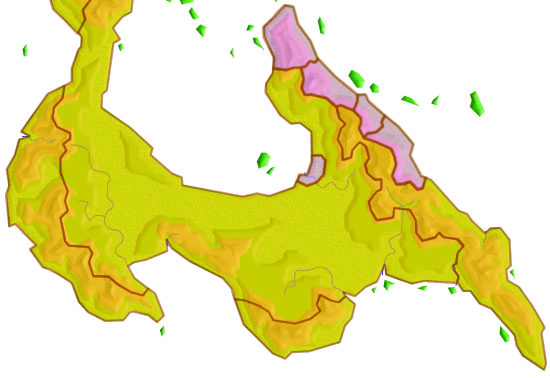Overview
Sul-Tèreðor is one of the most remote regions in the World of Teréth End. Located at the southern end of the Fiery Isthmus, this land mass has remained wild and unexplored for ages. Mountainous and heavily forested, the area appears to be a virgin wilderness teaming with all manner of birds and wildlife.The land of Sul-Tèreðor is bounded by the south Mar Dèkali to the east and the Mar Kìrydi to the west. It’s most dominant feature is the large Inner Sea which provides calm waters throughout its central crescent.
Explorers that have ventured inland have found a wonderland of unspoiled resources. The only evidence of civilization’s influence on the region is the throne of Tultāa Egn, the “Chair of the Sky”. This giant rock formation is sometimes visible from the sea among the cloudy mountain tops of the inner coast. No ports or harbors have been found along the shores, leading many to speculate why the people of the Fiery Isthmus have never spread into this fertile area. Expeditions to colonize the region have failed, one after the next, leading many to believe that someone or something presides over the area, guarding against all development.
The only thing that has been left by explorers and would-be colonists are their names on handful of coastal maps of Sul-Tèreðor. The most famous of these is Ehryghyrth’s Inlet on the eastern coast, site of a failed colony supported by the Lirís Illìur Trading Company. As of 415 DR, the company had made a large investment over almost a twenty year period by sending explorers and cartographers to the region to chart and find a suitable location for a colony. Comfortable with their research, the company sponsored six ships under the command of the captain Ehryghyrth, who had made the journey twice before. Within months of arrival, the company built a small fort and was sending frequent forays of trappers and hunters into the wilderness for pelts and living specimens to send back to Illyra. Ships laden with all manner of wonders were received at Lirís Illìur in the Spring of 416 DR. The company leased more ships and sent more colonists following this initial haul. Upon their arrival later that year, they could find no evidence of the fort or colony. News of the “Lost Colony” spread through Illyra quickly and the Lirís Illìur Trading Company was soon bankrupted.
Regions, Geographic
Regions, Political
Cities, Towns, and Villages
Landmarks
- Bird Island. Reportedly one of the most beautiful places in all the World of Teréth End, Bird Island is by all accounts a paradise in the south Mar Dèkali. Tranquil beaches and tall lush trees filled with fruits and birds of all colors and varieties. Toward the island’s center a series of springs issue in waterfalls from the top of a large basalt plateau. Expeditions to the plateau have been unsuccessful without magical aid. Hidden atop the formation are the abandoned ruins of what may be an ancient monastery, one of the few structures that have been discovered among the islands that surround Sul-Tèreðor. What makes these buildings more suspect is the fact that they are built upon a Lehyal knot.
- Karáskāa. The largest island of the eastern archipelago of Sul-Tèreðor, Karáskāa is also known as the “Rumbling Island”. The island is infamous for a volcanic explosion that is thought to have occurred there in 4/1469 ER. The explosion ejected a dark cloud that encircled the globe, plunging the world into twilight for months and creating fiery sunsets for years after. Old Empire historians have traditionally associated the event with the birth of Anðùs Terrud, the Lanàdra king credited with founding the Dekàli empire. Today, the forested island is striking to behold. Giant shards of stone stand among the trees as if mountains had ruptured like bottle glass. Those that have stood on the shores of Karaskaa claim to still feel rumblings within the earth. Some attribute this to aftershocks from the explosion two millennia earlier, while others feel it is a presage of things to come.
- Tultāa Egn. The Throne of the Gods is considered a world wonder.
